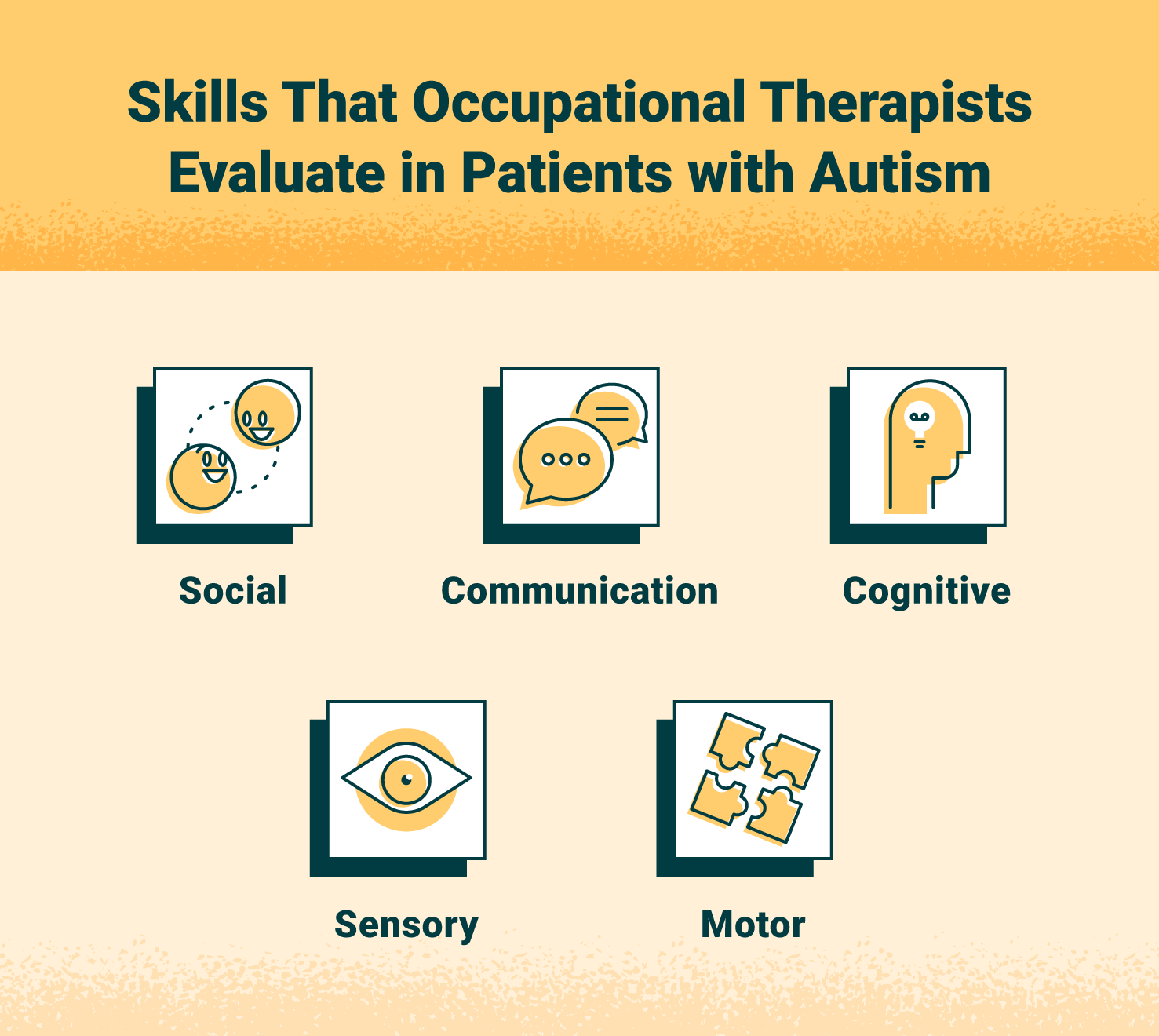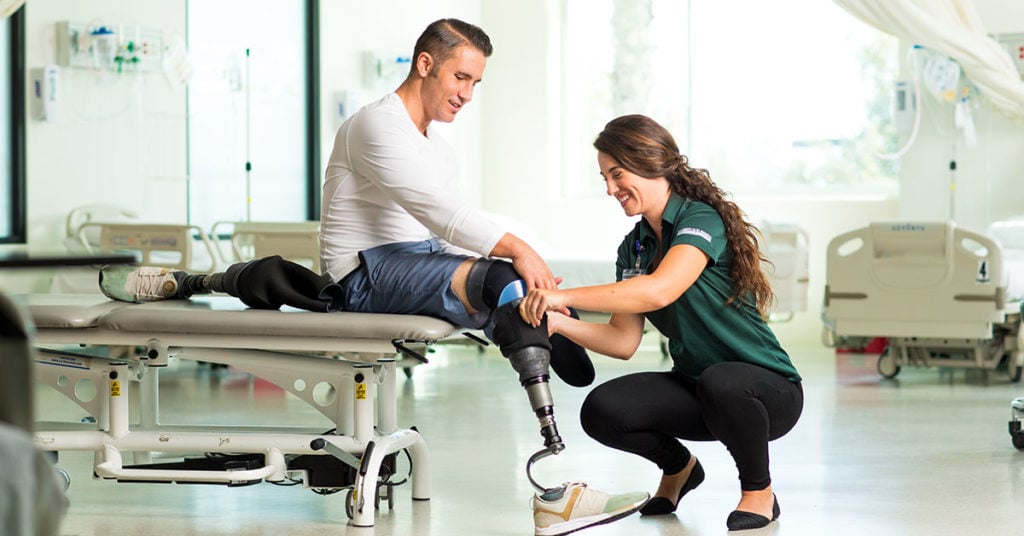

Autism spectrum disorder (ASD)1 is a neurodevelopmental condition characterized by impaired social communication skills, restricted and repetitive behaviors and isolated areas of interest. Approximately one in 36 children in the United States are diagnosed with ASD, which can be recognized as early as age two but is typically detected after age five.2
Early diagnosis and intervention can greatly improve outcomes for people with autism.3 One primary mode of intervention is occupational therapy (OT) for autism, which can play a unique role in helping individuals with ASD live more fully and independently.
What Is Occupational Therapy?
Occupational therapy is a field of healthcare that holistically treats people who have injuries, disabilities or other conditions, including autism. In this practice, occupational therapists (OTs) help patients develop, recover or maintain their ability to engage in meaningful daily activities, including effective communication.
OTs often begin the process by communicating directly with the patient and family to understand the patient’s individual needs. They assess the patient’s physical, sensory, emotional and cognitive abilities before developing reasonable goals and a treatment plan. The OT then usually works with the patient for several sessions or longer term to help them progress toward their goals.
The Role of Occupational Therapy for Autism Spectrum Disorder Treatment
Occupational therapy for autism evaluates the current developmental levels of children and adults with ASD, and aims to improve their ability to self-regulate emotions and participate in social interactions.4 Through interventions, an OT for autism can help individuals build strength and overcome limitations.
What Is Occupational Therapy for Autism?

To evaluate a patient, the OT may use screening tools such as an ASD checklist, a sensory profile, the Childhood Autism Rating Scale (CARS, or diagnosis criteria set forth in the fifth edition of the Diagnostic and Statistical Manual of Mental Disorders (DSM-5-TR).5,6 When observing the patient, an OT for autism will consider the following skills6:
- Social: Interactions with others, emotion regulation, behavior, desire for personal space, eye contact and aggression
- Communication: Speech and non-verbal communication
- Cognitive: Attention span and stamina
- Sensory: Responses to stimuli, sensory seeking and sensory defensiveness
- Motor: Posture, balance and manipulation of small objects


Common Occupational Therapy Interventions for Autism
After completing an evaluation, the OT for autism works with the patient and family to develop an intervention plan and treatment goals. Occupational therapy autism interventions may include7 :
- Sensory integration and sensory-based strategies
- Mental health and wellness treatment
- Emotional development and self-regulation strategies and programs
- Peer groups, social participation and play activities
- Self-care routines to help with daily activities such as bathing, feeding and grooming
- Motor development techniques
- Supporting an adolescent’s transition into adulthood and helping them build skills to enter the workforce
- Cognitive behavioral approaches to support positive behaviors
Benefits of Occupational Therapy for Autism
The main goal of occupational therapy for autism is to improve a patient’s quality of life. Through interventions, an OT for autism can help people with ASD gain independence and8:
- Focus on academic tasks
- Communicate appropriately
- Maintain and foster relationships
- Work with others to achieve a common goal or purpose
- Learn to delay gratification
- Express emotions in a healthy, productive way and manage self-regulation
- Become more independent and confident
- Feel less anxious


How to Find an OT for Autism
Contact a patient’s school or physician to find a qualified occupational therapist. When choosing an OT for autism to work with a child or adult, look for someone who is willing to9:
- Conduct a comprehensive diagnostic evaluation and create written goals for treatment
- Offer one-on-one treatment in a sensory-rich setting
- Provide an intensive treatment program that encourages family members to participate
- Ask questions and encourage the patient and family to do the same
Occupational therapy for autism can help people at all points along the spectrum develop the skills to communicate better and participate in meaningful daily activities. OT for autism practitioners are uniquely positioned to provide treatment that can help individuals with autism succeed.


Occupational therapy is a rewarding career path that allows for the opportunity to help people of all ages manage physical and cognitive disabilities and differences. Ready to learn more about how to become an OT and assist those with autism? Learn more about graduate occupational therapy programs at the University of St. Augustine for Health Sciences (USAHS).
USAHS is a leading choice for aspiring OTs. We offer two graduate occupational therapy programs:a Master of Occupational Therapy (MOT) and Doctor of Occupational Therapy (OTD). Expert faculty practitioners, compassionate support, cutting-edge technology, progressive learning models and a flexible curriculum are a few of our outstanding traits. Our enrollment team is here to help you determine which degree fits your lifestyle, preferences and personal and professional goals.
The entry-level occupational therapy master’s degree program at the Dallas, Texas, campus has applied for accreditation and has been granted Candidacy Status by the Accreditation Council for Occupational Therapy Education (ACOTE) of the American Occupational Therapy Association (AOTA), located at 6116 Executive Boulevard, Suite 200, North Bethesda, MD 20852-4929. ACOTE’s telephone number c/o AOTA is (301) 652-AOTA and its web address is www.acoteonline.org. The program must have a preaccreditation review, complete an on-site evaluation and be granted Accreditation Status before its graduates will be eligible to sit for the national certification examination for the occupational therapist administered by the National Board for Certification in Occupational Therapy (NBCOT). After successful completion of this exam, the individual will be an Occupational Therapist, Registered (OTR). In addition, all states require licensure in order to practice; however, state licenses are usually based on the results of the NBCOT Certification Examination. Note that a felony conviction may affect a graduate’s ability to sit for the NBCOT certification examination or attain state licensure.
Students must complete 24 weeks of Level II fieldwork within 24 months following completion of all prior didactic portions of the program
Sources:
- “Autism diagnosis criteria: DSM-5,” Autism Speaks, https://www.autismspeaks.org/autism-diagnosis-criteria-dsm-5
- “Autism statistics and facts,” Autism Speaks, https://www.autismspeaks.org/autism-statistics-asd
- Lonnie Zwaigenbaum, et al., “Early Identification and Interventions for Autism Spectrum Disorder,” Pediatrics, 2015;136(Supplement_1):S1-S9. https://pediatrics.aappublications.org/content/136/Supplement_1/S1
- Anne V. Kirby, Lisa Morgan, Claudia Hilton, “Autism and Mental Health: The Role of Occupational Therapy,” The American Journal of Occupational Therapy, 2023;77:2, https://research.aota.org/ajot/article/77/2/7702170010/24066/Autism-and-Mental-Health-The-Role-of-Occupational
- American Psychiatric Association, “Diagnostic And Statistical Manual Of Mental Disorders, Fifth Edition, Text Revision (DSM-5-TR),” Psychiatry Online, https://dsm.psychiatryonline.org/doi/book/10.1176/appi.books.9780890425787
- Payal Pawar, “Occupational Therapy for Autism – Assessment and Intervention,” Occupational Therapy {OT}. https://occupationaltherapyot.com/occupational-therapy-autism/
- Scott Tomchek, et al., “Occupational Therapy Interventions for Adolescents With Autism Spectrum Disorder,” American Journal of Occupational Therapy, 2016;71:1, https://research.aota.org/ajot/article/71/1/7101395010p1/6264/Occupational-Therapy-Interventions-for-Adolescents
- “How Does Occupational Therapy Benefit A Child with Autism?” Applied Behavior Analysis Programs Guide, https://www.appliedbehavioranalysisprograms.com/faq/how-does-occupational-therapy-benefit-a-child-with-autism/
- “Choosing an Occupational Therapist,” STAR Institute, https://www.spdstar.org/basic/choosing-an-occupational-therapist







